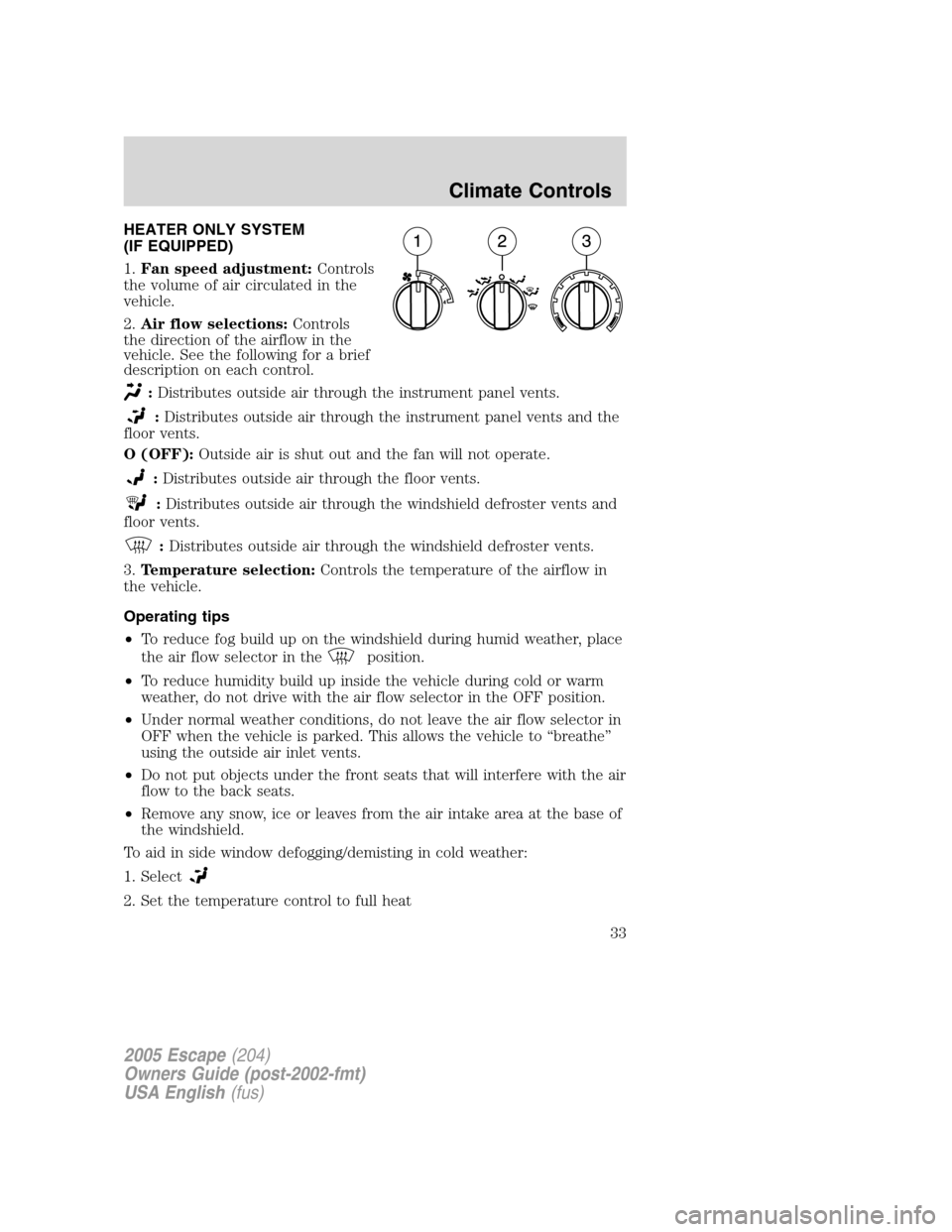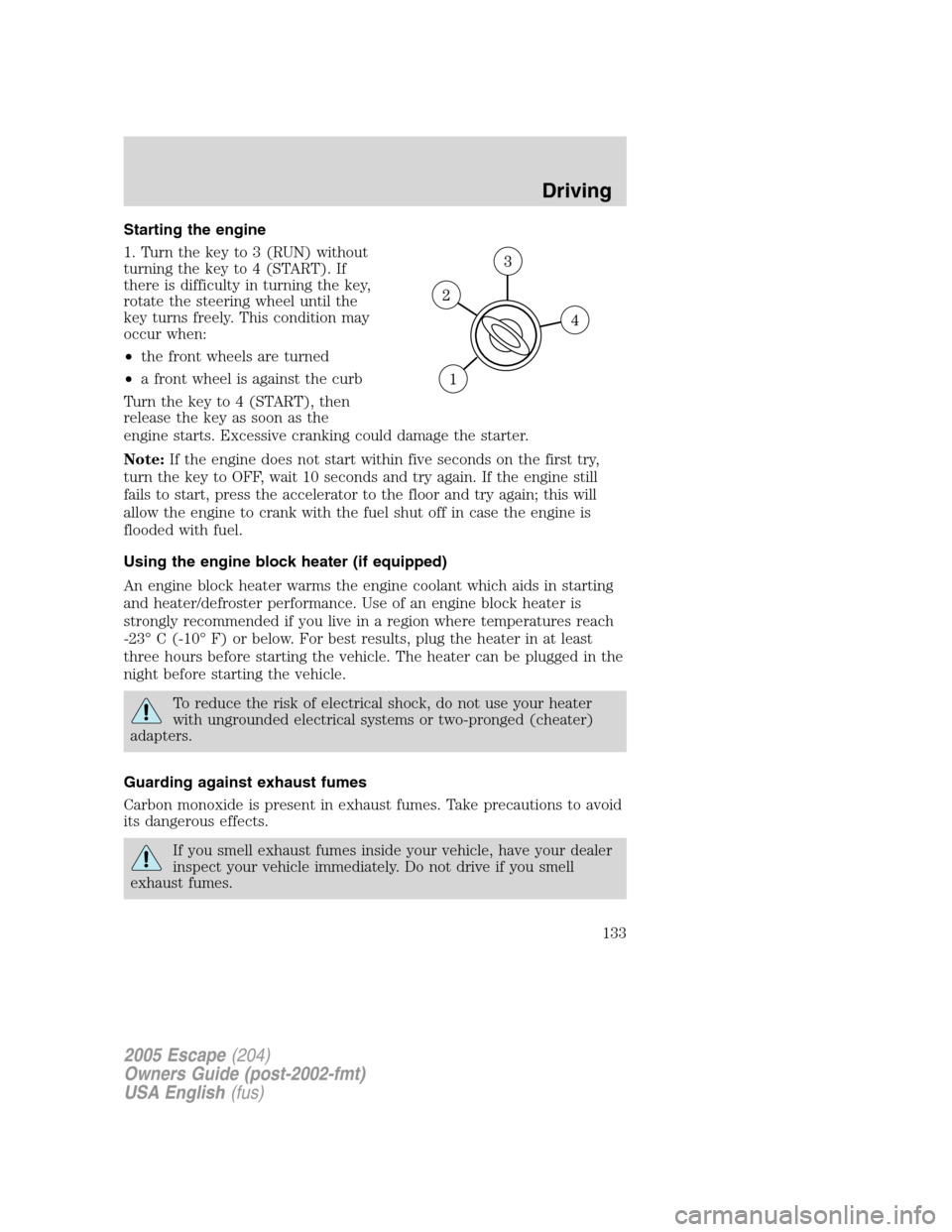2005 FORD ESCAPE heater
[x] Cancel search: heaterPage 1 of 272

Introduction 4
Instrument Cluster 10
Warning and control lights 10
Gauges 14
Entertainment Systems 16
AM/FM stereo with CD 16
AM/FM stereo cassette with CD 19
AM/FM stereo with in-dash six CD 23
Climate Controls 33
Heater only 33
Manual heating and air conditioning 34
Rear window defroster 35
Lights 36
Headlamps 36
Turn signal control 41
Bulb replacement 43
Driver Controls 48
Windshield wiper/washer control 48
Steering wheel adjustment 50
Power windows 53
Mirrors 54
Speed control 55
Message center 59
Locks and Security 77
Keys 77
Locks 77
Anti-theft system 84
Table of Contents
1
Page 33 of 272

HEATER ONLY SYSTEM
(IF EQUIPPED)
1.Fan speed adjustment:Controls
the volume of air circulated in the
vehicle.
2.Air flow selections:Controls
the direction of the airflow in the
vehicle. See the following for a brief
description on each control.
:Distributes outside air through the instrument panel vents.
:Distributes outside air through the instrument panel vents and the
floor vents.
O (OFF):Outside air is shut out and the fan will not operate.
:Distributes outside air through the floor vents.
:Distributes outside air through the windshield defroster vents and
floor vents.
:Distributes outside air through the windshield defroster vents.
3.Temperature selection:Controls the temperature of the airflow in
the vehicle.
Operating tips
•To reduce fog build up on the windshield during humid weather, place
the air flow selector in the
position.
•To reduce humidity build up inside the vehicle during cold or warm
weather, do not drive with the air flow selector in the OFF position.
•Under normal weather conditions, do not leave the air flow selector in
OFF when the vehicle is parked. This allows the vehicle to“breathe”
using the outside air inlet vents.
•Do not put objects under the front seats that will interfere with the air
flow to the back seats.
•Remove any snow, ice or leaves from the air intake area at the base of
the windshield.
To aid in side window defogging/demisting in cold weather:
1. Select
2. Set the temperature control to full heat
2005 Escape(204)
Owners Guide (post-2002-fmt)
USA English(fus)
Climate Controls
Climate Controls
33
Page 133 of 272

Starting the engine
1. Turn the key to 3 (RUN) without
turning the key to 4 (START). If
there is difficulty in turning the key,
rotate the steering wheel until the
key turns freely. This condition may
occur when:
•the front wheels are turned
•a front wheel is against the curb
Turn the key to 4 (START), then
release the key as soon as the
engine starts. Excessive cranking could damage the starter.
Note:If the engine does not start within five seconds on the first try,
turn the key to OFF, wait 10 seconds and try again. If the engine still
fails to start, press the accelerator to the floor and try again; this will
allow the engine to crank with the fuel shut off in case the engine is
flooded with fuel.
Using the engine block heater (if equipped)
An engine block heater warms the engine coolant which aids in starting
and heater/defroster performance. Use of an engine block heater is
strongly recommended if you live in a region where temperatures reach
-23°C (-10°F) or below. For best results, plug the heater in at least
three hours before starting the vehicle. The heater can be plugged in the
night before starting the vehicle.
To reduce the risk of electrical shock, do not use your heater
with ungrounded electrical systems or two-pronged (cheater)
adapters.
Guarding against exhaust fumes
Carbon monoxide is present in exhaust fumes. Take precautions to avoid
its dangerous effects.
If you smell exhaust fumes inside your vehicle, have your dealer
inspect your vehicle immediately. Do not drive if you smell
exhaust fumes.
2005 Escape(204)
Owners Guide (post-2002-fmt)
USA English(fus)
Driving
133
Page 187 of 272

Preparing your vehicle
When the battery is disconnected or a new battery is installed, the
transmission must relearn its shift strategy. As a result, the transmission
may have firm and/or soft shifts. This operation is considered normal and
will not affect function or durability of the transmission. Over time, the
adaptive learning process will fully update transmission operation.
1.Use only a 12–volt supply to start your vehicle.
2. Do not disconnect the battery of the disabled vehicle as this could
damage the vehicle’s electrical system.
3. Park the booster vehicle close to the hood of the disabled vehicle
making sure the two vehiclesdo nottouch. Set the parking brake on
both vehicles and stay clear of the engine cooling fan and other moving
parts.
4. Check all battery terminals and remove any excessive corrosion before
you attach the battery cables. Ensure that vent caps are tight and level.
5. Turn the heater fan on in both vehicles to protect any electrical
surges. Turn all other accessories off.
Connecting the jumper cables
1. Connect the positive (+) jumper cable to the positive (+) terminal of
the discharged battery.
Note:In the illustrations,lightning boltsare used to designate the
assisting (boosting) battery.
+–+–
2005 Escape(204)
Owners Guide (post-2002-fmt)
USA English(fus)
Roadside Emergencies
187
Page 266 of 272

Wheels
Interior style
Cell phone holders
Electrochromatic compass/temperature interior mirrors
Floor mats
Interior trim kits
Leather wrapped steering wheels
Scuff plates
Lifestyle
Bike racks
Cargo organization and management
Engine block heaters and blankets
Rear seat entertainment systems
Towing mirrors
Trailer hitches, wiring harnesses and accessories
Peace of mind
Airbag anti-theft locks
First aid and safety kits
Full vehicle covers
Locking gas cap
Navigation systems
Remote start
Vehicle security systems
2005 Escape(204)
Owners Guide (post-2002-fmt)
USA English(fus)
Accessories
266
Page 269 of 272

Engine block heater .................133
Engine oil ..................................213
checking and adding ..............213
dipstick ....................................213
filter, specifications ........216, 253
recommendations ...................216
refill capacities ........................254
specifications ..................257, 259
Exhaust fumes ..........................133
F
Fail safe cooling ........................223
Fluid capacities .........................254
Foglamps .....................................37
Four-Wheel Drive vehicles
driving off road .......................146
indicator light .........................146
preparing to drive your
vehicle .....................................137
Fuel ............................................225
calculating fuel
economy ............................60, 229
cap ...........................................226
capacity ...................................254
choosing the right fuel ...........227
comparisons with EPA fuel
economy estimates .................232
detergent in fuel .....................228
filling your vehicle
with fuel ..................225–226, 229
filter, specifications ........229, 253
fuel pump shut-off switch .....170
improving fuel economy ........229
octane rating ...................228, 259
quality ......................................228
running out of fuel .................228
safety information relating
to automotive fuels ................225
Fuses ..................................170, 172G
Garage door opener ....................51
Gas cap (see Fuel cap) ............226
Gas mileage
(see Fuel economy) .................229
Gauges .........................................14
GAWR (Gross Axle
Weight Rating)
calculating ...............................161
GVWR (Gross Vehicle
Weight Rating)
calculating ...............................161
H
Hazard flashers .........................169
Head restraints .....................89, 91
Headlamps ...................................36
aiming ........................................39
autolamp system .......................36
bulb specifications ....................43
daytime running lights .............37
flash to pass ..............................38
high beam .................................38
replacing bulbs .........................44
turning on and off ....................36
Heating
heater only system ...................33
Hood ..........................................210
I
Ignition ...............................130, 259
Infant seats
(see Safety seats) .....................122
Inspection/maintenance
(I/M) testing ..............................234
2005 Escape(204)
Owners Guide (post-2002-fmt)
USA English(fus)
Index
269